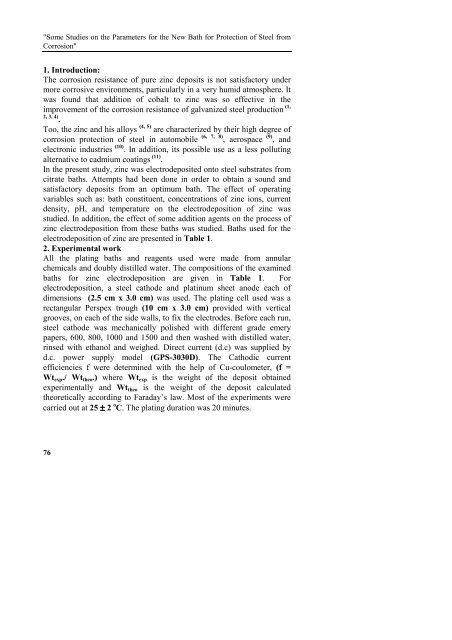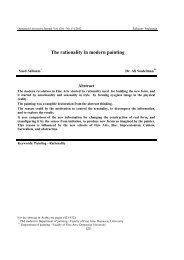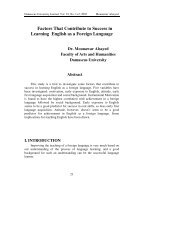"Some Studies on the Parameters for the New Bath for Protection of ...
"Some Studies on the Parameters for the New Bath for Protection of ...
"Some Studies on the Parameters for the New Bath for Protection of ...
You also want an ePaper? Increase the reach of your titles
YUMPU automatically turns print PDFs into web optimized ePapers that Google loves.
"<str<strong>on</strong>g>Some</str<strong>on</strong>g> <str<strong>on</strong>g>Studies</str<strong>on</strong>g> <strong>on</strong> <strong>the</strong> <strong>Parameters</strong> <strong>for</strong> <strong>the</strong> <strong>New</strong> <strong>Bath</strong> <strong>for</strong> Protecti<strong>on</strong> <strong>of</strong> Steel fromCorrosi<strong>on</strong>"1. Introducti<strong>on</strong>:The corrosi<strong>on</strong> resistance <strong>of</strong> pure zinc deposits is not satisfactory undermore corrosive envir<strong>on</strong>ments, particularly in a very humid atmosphere. Itwas found that additi<strong>on</strong> <strong>of</strong> cobalt to zinc was so effective in <strong>the</strong>improvement <strong>of</strong> <strong>the</strong> corrosi<strong>on</strong> resistance <strong>of</strong> galvanized steel producti<strong>on</strong> (1,2, 3, 4) .Too, <strong>the</strong> zinc and his alloys (4, 5) are characterized by <strong>the</strong>ir high degree <strong>of</strong>corrosi<strong>on</strong> protecti<strong>on</strong> <strong>of</strong> steel in automobile (6, 7, 8) , aerospace (9) , andelectr<strong>on</strong>ic industries (10) . In additi<strong>on</strong>, its possible use as a less pollutingalternative to cadmium coatings (11) .In <strong>the</strong> present study, zinc was electrodeposited <strong>on</strong>to steel substrates fromcitrate baths. Attempts had been d<strong>on</strong>e in order to obtain a sound andsatisfactory deposits from an optimum bath. The effect <strong>of</strong> operatingvariables such as: bath c<strong>on</strong>stituent, c<strong>on</strong>centrati<strong>on</strong>s <strong>of</strong> zinc i<strong>on</strong>s, currentdensity, pH, and temperature <strong>on</strong> <strong>the</strong> electrodepositi<strong>on</strong> <strong>of</strong> zinc wasstudied. In additi<strong>on</strong>, <strong>the</strong> effect <strong>of</strong> some additi<strong>on</strong> agents <strong>on</strong> <strong>the</strong> process <strong>of</strong>zinc electrodepositi<strong>on</strong> from <strong>the</strong>se baths was studied. <strong>Bath</strong>s used <strong>for</strong> <strong>the</strong>electrodepositi<strong>on</strong> <strong>of</strong> zinc are presented in Table 1.2. Experimental workAll <strong>the</strong> plating baths and reagents used were made from annularchemicals and doubly distilled water. The compositi<strong>on</strong>s <strong>of</strong> <strong>the</strong> examinedbaths <strong>for</strong> zinc electrodepositi<strong>on</strong> are given in Table 1. Forelectrodepositi<strong>on</strong>, a steel cathode and platinum sheet anode each <strong>of</strong>dimensi<strong>on</strong>s (2.5 cm x 3.0 cm) was used. The plating cell used was arectangular Perspex trough (10 cm x 3.0 cm) provided with verticalgrooves, <strong>on</strong> each <strong>of</strong> <strong>the</strong> side walls, to fix <strong>the</strong> electrodes. Be<strong>for</strong>e each run,steel cathode was mechanically polished with different grade emerypapers, 600, 800, 1000 and 1500 and <strong>the</strong>n washed with distilled water,rinsed with ethanol and weighed. Direct current (d.c) was supplied byd.c. power supply model (GPS-3030D). The Cathodic currentefficiencies f were determined with <strong>the</strong> help <strong>of</strong> Cu-coulometer, (f =Wt exp ./ Wt <strong>the</strong>o .) where Wt exp is <strong>the</strong> weight <strong>of</strong> <strong>the</strong> deposit obtainedexperimentally and Wt <strong>the</strong>o is <strong>the</strong> weight <strong>of</strong> <strong>the</strong> deposit calculated<strong>the</strong>oretically according to Faraday’s law. Most <strong>of</strong> <strong>the</strong> experiments werecarried out at 25 ± 2 o C. The plating durati<strong>on</strong> was 20 minutes.76
















